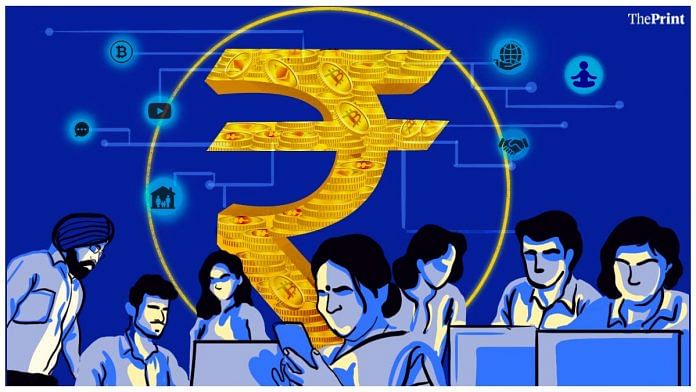The post-Covid world is witnessing an explosion of the global digital services sector. This time it’s not just about software engineers.
An increasing number of businesses, households and institutions around the world are now engaged in the digital gig economy in some form or the other. From yoga classes to accounting, the demand for services which can be met from anywhere in the world, has boomed after the pandemic.
How can policymakers ensure that the Indian labour force and the economy benefit from the growth of the digitally connected global services market?
In this new world, India has huge potential benefits. It has the world’s largest and youngest workforce. The young are particularly good at picking up new technologies and ways of working. They take to the world of mobile apps and digital transactions quickly and are nimble at learning new skills. The English language is an added advantage. Compared to any other country, India has the most to offer at competitive rates.
The question is whether policymaking in India will provide a conducive environment for the country’s youth to take advantage of these opportunities.
Also read: Protecting livelihoods is the next frontier for India in the fight against climate change
India’s advantage
China rode the wave of global large scale manufacturing exports growth while India missed that bus. In terms of initial conditions, India now has a better capability of catching the next wave of growth happening in services.
This growth explosion can have many components. From traditional software services exports to new ones like legal, medical, accounting, education, and well-being, the next driver of global growth is socially and culturally more suited to India.
With its young demographics and working population, India has been quickly able to plug into the growing digital services sector. From BPO and software coding to teaching yoga, languages, cooking, telemedicine, edu-tech, logistics management and so much more, young Indians are directly participating in these rapidly expanding services. These do not require significant investments in capital. They can be done in work-from-home mode.
Living in India allows us to offer services at highly competitive rates. In this way this is similar to the software, BPO, KPO (knowledge process outsourcing) boom that happened in the organised and large scale sectors — but that also rode on the low price of labour and cheaper cost of living in India.
Tier-2 and tier-3 cities and work-from-home mode offers an even bigger cost advantage than call centres in metros. High unemployment among educated young females offers a large pool of potential workers.
In the context of the software boom of the 2000s it has often been said that one of the factors responsible for the boom was the lack of interference by the government. On the one hand, the government reformed the telecom sector and allowed broadband. On the other, its policies didn’t interfere in the software services sector and hinder growth.
Also read: These IPOs are under extra scrutiny after Paytm’s disaster debut
Policy framework
The reform agenda in India is generally not so much about what the government should do, but rather about what restrictions it needs to remove.
So, while international trade treaties may allow Indian firms export services like legal, medical, accounting and software more easily, restrictions on cross-border digital payments prevent people from taking full advantage of available opportunities.
Making cross-border payments as easy as domestic digital payments can help small businesses, individuals and households to participate in global trade.
The large fiscal stimulus in the US and Europe has increased demand for manufactured goods by households. On the political front, the main focus of job protection has been in the manufacturing sector that has moved to China.
Labour unions and voters demand factories to be back in the US. Demand for services by households has also increased and is set to rise further. There is scope for companies in the US and Europe to hire individuals directly in work-from-home mode.
Today, we can conceive of a world where educated Indian women in tier-2 and tier-3 cities could be working from home for US companies — say analysing data from medical devices.
The job of the Indian state would primarily be to provide a framework that does not prevent such job and income growth. The energy and enthusiasm of the Indian youth and the competitive prices that living in the country offers will do the rest.
India’s experience with digital payments has been a tremendous learning process. Businesses across the country are now participating in markets and the ‘formal’ sector.
The ability to participate in alternate payment systems should not be prevented. Fears of money laundering and terror financing are relevant for all countries. Organisations like the Financial Action Task Force (FATF), the global watchdog for money laundering and terror financing, and laws like the Prevention of Money Laundering Act deal with these issues.
Many FATF member countries have regulated and allowed digital payments including cryptocurrencies. Disclosure norms and KYC requirements are part of these frameworks, but not so onerous that they prevent people from participating.
Looking forward, as cryptocurrencies or other modes of payment like a Facebook currency or other digital payment systems become increasingly used in the US, Europe, the UK, Japan and other rich countries, it will be critical for Indians to be able to accept these payments in the currencies if that is what buyers want to use.
The job of policymakers is to strike a balance between fear and innovation. Banning cryptocurrencies, stable coins and other digital payments will reduce the possibility of higher earnings for Indian households as rich countries see growth.
Ila Patnaik is an economist and a professor at National Institute of Public Finance and Policy.
Views are personal.
Also read: More than half of Indians don’t want cryptocurrency legalised, survey shows



